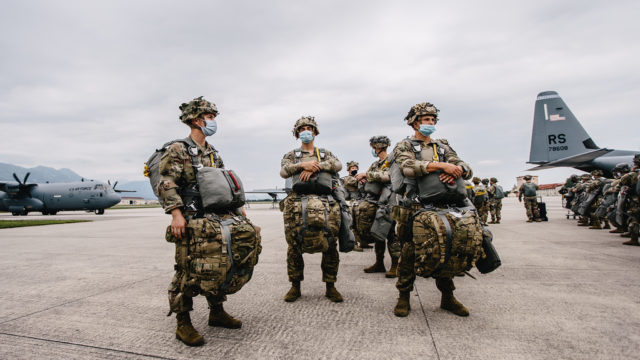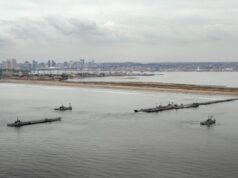
A year ago, the U.S. Army was busy retooling from counterinsurgency to long term competition with China and Russia. Its focus was on what it called “multi-domain operations” particularly in the Indo-Pacific region, and on modernizing to fight large conventional operations. Then came the COVID-19 pandemic. For the U.S. Army – as for every element of American society and government – much changed in a matter of months.
The Army’s initial response was exactly as it should have been. Using mostly the National Guard, the Army rushed to help overwhelmed civilian authorities, constructing emergency field hospitals and, in some states, helping operate elderly care homes and prisons. Once civilian authorities began to get a handle on the medical crisis, they needed less direct support from the military. Then – again exactly as it should – the Army began thinking about what the COVID-19 pandemic might mean for it over the long term. This has only just begun – no one knows the precise extent or direction of change that the pandemic will produce.
“Bump in the Road”
Most security experts and Department of Defense officials expect the pandemic to represent a temporary “bump in the road” rather than the beginning of a revolution. Thinkers in this camp believe that once a vaccine appears and the pandemic ends, the United States and its Army must return to the business at hand: managing the competition with Russia and especially China. China will be the focus of American strategy for years to come so the Army must be optimized to deter and defeat it. This is a big job. As a recent report from the U.S. Army War College Strategic Studies Institute put it, “the United States is out of position for multi-domain competition and multi-domain conflict” so the Army’s priority should be adopting four “transformational roles” to address China’s regional and global assertiveness.
For “bump in the road” thinkers, the goal is moving past the temporary distraction created by the pandemic and transcending or offsetting its effects, particularly on defense spending. The worst that many analysts consider likely is a return to the “austere” sequestration budgets seen at the end of the Obama administration. This might require modest Army force reductions and cuts or delays in modernization plans, but it would be an adjustment, not a revolutionary transformation. The Army’s strategic role and its basic organization would remain the same.
The Revolutionary Transformation
There is, though, a very different alternative. Rather than a temporary bump in the road, the COVID-19 pandemic may be a catalyst for revolutionary change in the global security system and in American security strategy, amplifying and speeding macro-level shifts that had already begun. It is possible, as British journalist John Gray predicted, that:
The era of peak globalisation is over. An economic system that relied on worldwide production and long supply chains is morphing into one that will be less interconnected. A way of life driven by unceasing mobility is shuddering to a stop. Our lives are going to be more physically constrained and more virtual than they were. A more fragmented world is coming into being that in some ways may be more resilient.
The result, according to American science journalist Laurie Garrett, “could be a dramatic new stage in global capitalism, in which supply chains are brought closer to home and filled with redundancies to protect against future disruption.” Some regions and areas will benefit, using robotics, artificial intelligence, and additive manufacturing to partially delink from the globalized economy. This would give advanced regions the option to disengage from poorer ones, relying on technology to replace the low-cost labor that previously came from abroad. In the broad sense nations could practice the strategic equivalent of “social distancing.”
This would have immense effects on American strategy, undercutting the longstanding assumption that the United States must be concerned with security everywhere because in an interconnected world, instability and insecurity in even faraway places resonates in the homeland. Jobs in Indiana, the old argument went, depend on stability in the Middle East. For decades, this thinking justified an expansive strategy and an expeditionary military, including an Army capable of global power projection. But if the pandemic leads to partial deglobalization as Gray and others predict, the United States could resist the urge to attempt managing stability far from the homeland. And if promoting security around the world was not a vital U.S. interest, it would be hard to justify an increasingly expensive, expeditionary military. Hence at the same time that the United States faces immense costs from pandemic recovery and the need to build national resiliency against future disasters, the strategic rationale for keeping a powerful expeditionary military would fade.
Some defense experts might contend that if the United States de-emphasized global power projection, Russia and China would simply step in as America disengaged from parts of the world and become hegemonic. This seems improbable. If anything, deglobalization will affect China, with its export focused economy, impending demographic challenges caused by decades of a “one child” policy, and mounting climate change issues, more than the United States. In all likelihood Chinese and Russian security strategy also will change dramatically in the coming decade.
Deglobalization is only one component of the revolutionary change that COVID-19 is unleashing. The pandemic also may reshape the global security system by causing widespread state collapse as weak governments are hammered by the immediate cost of recovery from the pandemic, the loss of remittances and trade as the world undergoes partial deglobalization, the localization of manufacturing, the loss of foreign assistance as the richer nations struggle to pay for pandemic recovery, and the mounting challenge of climate change. Interminable conflicts and humanitarian disasters like Syria or Yemen may become tragically common. But as the United States struggles with the costs of the COVID-19 crisis and the post-pandemic challenge of building national resilience, it would be unlikely to intervene in collapsed states, at least outside the Western Hemisphere.
All of this may speed an ongoing – and historic – shift in the way that Americans think about security. Traditionally, national security meant defense against identifiable adversaries, mostly foreign. Enemies had to be contained, deterred and, if necessary, defeated. This was delegated to security professionals whether civilian or military. Most of the public was only involved in security by paying taxes and electing officials who supported it. This conceptualization reflected the conditions of the 20th century but now is dated. Today’s security environment is characterized by a blurred distinction between foreign and domestic threats; informational saturation which fuels partisanship and makes the United States vulnerable to manipulation; the ability of nonstate adversaries to attack the United States; the “weaponization of everything”; and the growing salience of non-adversary threats like pandemics, environmental disasters, climate change, and economic crises.
Even before COVID-19, the United States was slowly moving toward a “triangular” conceptualization of security simultaneously focused on identifiable adversaries, clandestine adversaries, and non-adversary threats. From this perspective, homeland security rather than security abroad – power projection and expeditionary military capability – would be the priority in resource allocation, national resiliency more important than defeating or deterring external enemies. The military would be an important component of an integrated, homeland-focused security organization but more in a supporting role, its value assessed by its contribution to national resiliency rather the ability to defeat enemies on the battlefield.
The COVID-19 pandemic did not create these trends but may accelerate and amplify them, pushing the United States toward a revolutionary transformation in the way it thinks about and organizes for security.
Changes for the U.S. Army
Clearly the “bump in the road” scenario would mean business as usual for the Army while the “revolutionary transformation” one would require a wholesale redesign. The economic costs of pandemic recovery and the ensuing shift to holistic, homeland-focused security with a robust public health component will cut deeply into Army acquisitions and modernization. This will be particularly true of systems designed for warfighting against adversary armed forces. Rather than being optimized to fight identifiable enemies, the “revolutionary transformation” Army would need to fight identifiable enemies, confront clandestine adversaries, and support civilian authorities as they build national resiliency against non-adversary threats – all at the same time.
While it is impossible to predict how much the Army would shrink in the revolutionary transformation” scenario, there would be significant force structure cuts. Given the vital role of the National Guard in support of civil authorities, the cuts are likely to fall heavily on the active component. Eventually the U.S. Army might be composed mostly of the National Guard. As the Army’s priority shifted from war-fighting to support and participation in an integrated, homeland-focused security system and organization, support to civil authorities would increase in importance. The possibility – even probability – of future pandemics will increase the emphasis on networked autonomous operations in the Army. The COVID-19 pandemic is likely to diminish Army involvement in working directly with security partners, shifting toward virtual training and advice.
The “bump in the road” and the “revolutionary transformation” scenarios are the outer boundaries of the effects that the COVID-19 pandemic may have on the Army. In reality the Army’s future probably lies somewhere in between the two. But America’s national leaders, rather than the Army itself, will determine the service’s future. National leaders must decide whether the COVID-19 pandemic requires thinking differently about security or simply is a temporary distraction from the normal state of affairs. Is the future of American security deterring and possibly defeating foreign adversaries the way it has been for more than a century, or is it building holistic national resiliency against the triad of challenges? How this question is answered will determine not only what the future U.S. Army will look but also what, in the broadest sense, it will do to promote national security.
Today it makes sense for the Army to plan for some budget and force structure cuts, and to continue to focus on multi-domain operations, particularly in the Indo-Pacific regions. But it also should be thinking about revolutionary transformation, assessing how it would remain effective if ordered to take significant force cuts and play a supporting role in the building of national resiliency rather than a leading role in defeating foreign enemies.
At this point it may be too soon to begin revolutionary transformation but the Army should undertake a wide ranging program of analysis and research to develop some idea of how to do it if required. The Army has undertaken revolutionary change before, most recently in the 1940s. Now it may have to do so again but this time it will be a very different sort of revolution.
Steven Metz, Ph.D., is Professor of National Security and Strategy in the Department of National Security and Strategy at the U.S. Army War College.





